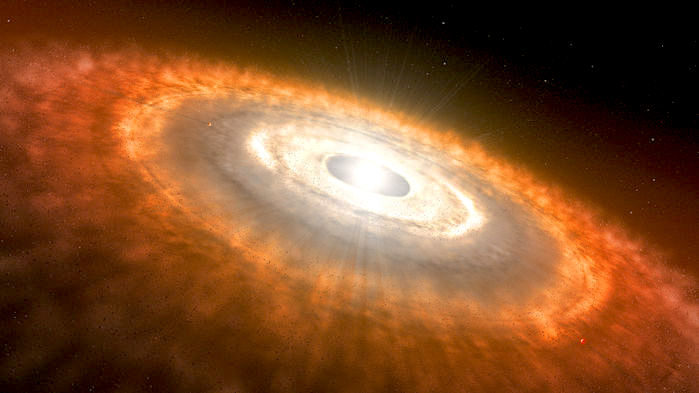
Scientists have found a new window into the early dynamics: a curious chemical divide in the dozens of species of meteorites. The picture has emerged over several years, but in work presented last week at the Lunar and Planetary Science Conference here, a group of German geochemists reported clinching evidence. They tested 32 meteorites representing nearly all known types and found that "any meteorite you take, it belongs to either one of these groups," says Thorsten Kleine, a geochemist at the University of Münster in Germany who led the work.
Those divergent chemistries imply distinct origin stories for asteroids, the parent bodies of most meteorites. One group formed from grist that began near the current location of the asteroid belt. The others coalesced much farther out, beyond a proto-Jupiter, near where Saturn orbits today. Only later, pushed and pulled by the wandering giant planets, did these immigrant asteroids find their home in today's asteroid belt. Bill Bottke, a planetary dynamicist at the Southwest Research Institute (SwRI) in Boulder, Colorado, thinks the chemical divide holds other clues to the timing and formation of the planets. "It really seems to be a powerful mechanism for understanding our solar system."
Paul Warren, a meteoriticist at the University of California, Los Angeles, was the first to notice what has come to be called the Warren gap. He gathered measurements of chromium and titanium isotopes for two meteorite types. Those metals, forged by the explosions of dying stars, were mixed throughout the disk of gas and dust from which planets and asteroids took shape. Warren expected his meteorites to display a continuum of isotopic abundances, because he assumed they had formed across the one broad region of the asteroid belt. Instead, he found that, in one meteorite type, called carbonaceous chondrites, the isotope levels were starkly different from other types. "I knew a good thing when I saw it," he says.
In a 2011 study, Warren argued that such a dichotomy could exist only if the two groups were separated for millions of years at formation. The most plausible source of that split was a void created by the gravity of a proto-Jupiter. But carbonaceous chondrites are known to have formed later than other meteorites - so it was possible that their peculiar isotopic chemistry reflected changes over time in the disk, rather than a distinct place of origin.
A few years ago, Kleine's group began looking at isotopes of molybdenum, another metal, and found a Warren gap there, too. It also found that iron meteorites fell into two populations even though they must all have formed at about the same time. That meant a physical barrier. "And the most obvious one would be Jupiter," Kleine says.
Kleine's team began spelling out the implications: By 1 million years after the solar system's start, Jupiter's core had grown large enough to sweep up dust in its path, creating a barrier. A new influx of metalrich dust to the solar system, perhaps from a nearby supernova, would have augmented isotopes in the outer asteroids but not the inner ones. Then, 3 million to 4 million years later, Jupiter migrated inward, mixing the two reservoirs. The Warren gap is both a validation of dynamic solar system models that predict a similar scenario, and a constraint they must reckon with, says Kevin Walsh, a SwRI dynamicist.
Now, scientists are gleaning other clues about the early solar system from the meteorites. One group is studying rare meteorites that mix up carbonaceous and noncarbonaceous components, a hint that they formed just after Jupiter's migration, in an effort to date when the two reservoirs combined. And by comparing molybdenum isotopes in rocks from Earth's mantle with those in meteorites, Kleine's team has found preliminary signs that Earth's water was partially delivered by a shower of impactors from the more distant asteroid population.
The meteorite studies could even set back the clock on the age of the 4.6-billion-year-old solar system itself. That date comes from the decay of uranium in calcium-aluminum-rich inclusions in meteorites. These little metal snowflakes, created by the sun's heat, are thought to have arisen in the earliest years of the solar system. But scientists have long wondered why carbonaceous meteorites are richer in these snowflakes. It appears that the inclusions are also isotopically similar to the outer solar system meteorites. Researchers now speculate that they formed far from the sun, driven by heat from a proto-Jupiter. If so, some inclusions must have formed after Jupiter took shape, meaning they are at least 1 million years younger than the solar system. "A huge advance," Bottke said. "My jaw was on the floor about that."
Meanwhile, the hunt is on to interpret other meteorites in this new light. It's amazing to think that samples on Earth originated near Saturn, Bottke says. "A few years ago if you had said that you would have had people laugh at you."



Reader Comments
The problem with the entire scenario is their assumptions about the early solar system, starting with the uniformitarian perspective.